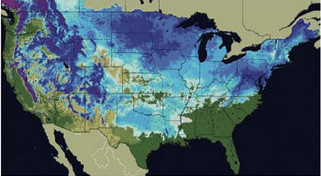
The National Oceanic and Atmospheric Administration released its winter 2010 outlook yesterday and the effects of La Niña are forecast to bring extremes to many places. Closer to home Colorado’s outlook is for a warm winter with equal chances of above, near or below normal precipitation.
La Niña conditions have been strengthening in the Pacific which means that water temperatures are cooler than normal. By contrast, El Niño is the opposite – warmer than normal sea temperatures. These conditions can have a big effect on weather patterns and can lead to extreme weather events.
“La Niña is in place and will strengthen and persist through the winter months, giving us a better understanding of what to expect between December and February,” said Mike Halpert, deputy director of the Climate Prediction Center – a division of the National Weather Service. “This is a good time for people to review the outlook and begin preparing for what winter may have in store.”
- Are you ready for winter? Check out our Winter Weather Preparedness series.
The outlook forecasts a colder and wetter than normal winter for the Pacific Northwest stretching across to the northern Rockies. Much of the south and southwest is expected to see warmer and drier than normal conditions.
NOAA says Colorado can expect warmer than average conditions in the period through February 2011. In terms of precipitation, the service does not see any factors that would push us toward one extreme or the other. As such we have equal chances of above, near or below normal precipitation – essentially a 33 1/3% chance of each.

Highlights from other regions include:
- Pacific Northwest: colder and wetter than average. La Niña often brings lower than average temperatures and increased mountain snow to the Pacific Northwest and western Montana during the winter months, which is good for the replenishment of water resources and winter recreation but can also lead to greater flooding and avalanche concerns;
- Southwest: warmer and drier than average. This will likely exacerbate drought conditions in these areas. All southern states are at risk of having above normal wildfire conditions starting this winter and lasting into the spring;
- Northern Plains: colder and wetter than average. Likely to see increased storminess and flooding;
- Southern Plains, Gulf Coast States & Southeast: warmer and drier than average. This will likely exacerbate drought conditions in these areas. All southern states are at risk of having above normal wildfire conditions starting this winter and lasting into the spring;
- Florida: drier than average, with an equal chance for above-, near-, or below-normal temperatures. Above normal wildfire conditions;
- Ohio and Tennessee Valleys: warmer and wetter than average. Likely to see increased storminess and flooding;
- Northeast and Mid-Atlantic: equal chances for above-, near-, or below-normal temperatures and precipitation. Winter weather for these regions is often driven not by La Niña but by weather patterns over the northern Atlantic Ocean and Arctic. These are often more short-term, and are generally predictable only a week or so in advance. If enough cold air and moisture are in place, areas north of the Ohio Valley and into the Northeast could see above-average snow;
- Central U.S.: equal chances of above-near-or below normal temperatures and precipitation;
- Hawaii: drier than normal through November, then wetter than normal December through February. Statewide, the current drought is expected to continue through the winter, with several locations remaining on track to become the driest year on record. Drought recovery is more likely on the smaller islands of Kauai and Molokai, and over the windward slopes of the Big Island and Maui;
- Alaska: odds favor colder than average temperatures with equal chances of above or below normal precipitation. The interior and southern portions of the state are currently drier than normal. A dry winter may set Alaska up for a greater chance of above normal wildfire conditions in the spring.










